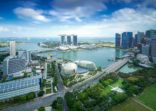Within the region, no country is expected to have a decline in insolvencies, according to the study.
|
Country |
2016 year-on-year change |
2017 change forecast |
|
Singapore |
2% |
15% |
|
China |
20% |
10% |
|
Taiwan |
27% |
5% |
|
Hong Kong |
0% |
5% |
|
South Korea |
-23% |
3% |
|
Japan |
-3% |
1% |
|
Australia |
-7% |
0% |
|
New Zealand |
-8% |
0% |
Source: Euler Hermes
The high rate for Singapore is attributed to a slowdown of its economy, Mahamoud Islam, a Hong Kong-based senior Asia economist at Euler Hermes, told FSA.
Previously, the Lion City’s long-term growth average was at 6%, but it is now way below that, Islam said.
In 2016, Singapore’s GDP grew only by 1.8%, which is lower than 2015’s 2%, according to government data.
Singapore is also affected by the downturn in global trade, according to Islam. Currently, global trade volume is below 4% annual growth, which is below the annual average of 7% from 2002-2008.
“For countries that are relying on trade, this is a problem,” he said.
Separately, the mediocre growth from the global economy has not only affected some of Singapore companies’ abilitity to repay their debt, but also the total amount of debt issued, according to Monetary Authority of Singapore’s latest survey of Singapore’s corporate debt market.
Total debt issuance reached S$174bn ($122.18bn) in 2015, the latest figures available. It is 13% lower compared to S$200bn in 2014. During the same period, the number of issuers declined by 17 to 132 issuers.
Sector risk
Because of slower growth and trade, the sectors that are at risk in Singapore are the construction and commodity-related sectors, according to Islam.
“The low demand in terms of global trade [explains] why you didn’t have a strong increase of heavy machinery demand in the world,” he said.
According to the study, there were four major insolvencies in Singapore from the first to the third quarter of 2016. All of them had construction- and commodities-related activities.
|
Company |
Activity |
|
Dragon Technology Distribution |
Machinery/equipment |
|
Sembawang Engineers and Constructors |
Construction |
|
Searights Maritime Services |
Transportation |
|
Swiber Holdings |
Energy |
Source: Euler Hermes
Also, in Singapore’s bond market several issuers from the oil and gas sectors ran into financial difficulties in 2016, arising from protracted weakness in energy prices, according to the MAS survey.
One of them vessel chartering group Swissco Holdings, which wanted to refinance S$100m of notes due 2018, according to a Bloomberg report in October last year.
At the time, three bond defaults occurred from the period November 2015 to October 2016. They included PT Trikomsel Oke, Pacific Andes Resources Development and Swiber Holdings.
The three missed payments on local notes cumulatively totalling S$875m.
Omar Slim, Pinebridge Investments’ Singapore-based co-manager for the firm’s Singapore Bond Fund, said that some companies that issued bonds and had difficulties are in the commodities sectors.
“That segment had some issues and it remains, to an extent, challenged,” he said.
Slim noted that his fund focuses on higher-rated bonds.
The fund’s highest bond allocation in terms of credit ratings is in AAA bonds (33.32%), followed by B (31.19%), A (23.84%), non-rated (6%), AA (3.73%) and money market (1.92%), according to FE data.
Around 66% of the fund is invested in corporate bonds and 33% in government bonds.
Although he said that some of the marginal companies that issued bonds had difficulties, he remains positive on the Singapore market and Asia as a whole.
“The corporate default rates in Asia are lower than what we’re seeing outside of Asia,” he said.
According to the Euler Hermes study, Asia-Pacific insolvencies are expected to rise by 6% this year. The figure is lower than Africa and the Middle East (9%) and Latin America (12%).
However, Slim said that the Singapore fixed income market is not immune to risks coming from the US and Europe.
“We see that the yield levels will continue to move sideways as we have seen in the past month or so until we get clarity on some of the US policies as well as the political risk out of some jurisdictions in Europe,” he said.
Slim currently has a defensive positioning in his portfolio, he said, adding that he likes more of the defensive sectors and some of the financials, utilities and top-tier real estate companies.
Performance of the fixed income – Singapore sector from November 2015 to end-2016. A steep decline was seen in the sector after US elections in November.

















